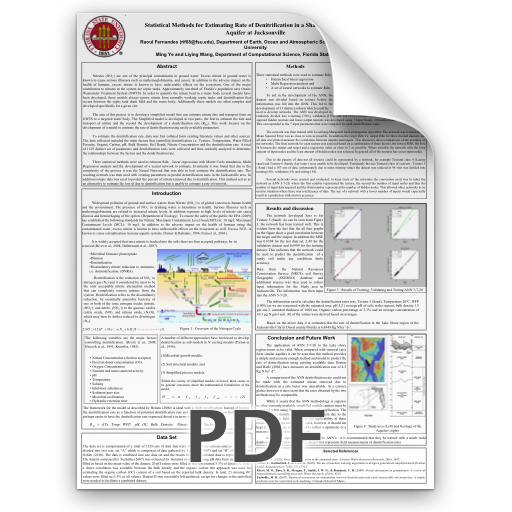
Statistical Methods for Estimating Rate of Denitrification in a Shallow Ground Water Aquifer at Jacksonville
Abstract
Nitrates (NO3-) are one of the principal contaminants in ground water. Excess nitrate in ground water is known to cause serious illnesses such as methemoglobinemia, and cancer. In addition to the adverse impact on the health of humans, excess nitrate is known to have unfavorable effects on the ecosystem. One of the major contributors to nitrates in the system are septic tanks. Approximately one-third of Florida’s population uses Onsite Wastewater Treatment System (OWTS). In order to quantify the nitrate load to a water body several models have been developed, these models always ignore nitrate form normally working septic tanks and denitrification that occurs between the septic tank drain field and the water body. Additionally these models are often complex and developed specifically for a given site.
The aim of this project is to develop a simplified model that can estimate nitrate fate and transport form an OWTS to a targeted water body. The Simplified model is developed in two parts, the first to estimate the fate and transport of nitrate and the second the development of a denitrification rate (Rdn). This work focuses on the development of a model to estimate the rate of denitrification using easily available parameters.
To estimate the denitrification rate, data was first collated form existing literature values and other sources. The data collected included the main factors that controlled denitrification i.e. Texture, Temperature, Water Filled Porosity, Organic Carbon, pH, Bulk Density, Soil Depth, Nitrate Concentration and the denitrification rate. A total of 1129 distinct set of parameters and denitrification rates were collected and then statically analyzed to determine the relationships between the factors and the denitrification rate.
Three statistical methods were used to estimate Rdn, , linear regressions with Monte Carlo simulation, Multi Regression analysis and the development of a neural network to estimate. Eventually it was found that due to the complexity of the process it was the Neural Network that was able to best estimate the denitrification rate. The resulting network was then used with existing parameters to predict denitrification rates in the Jacksonville area. In addition isotope data was used to predict the percent of nitrate removed due to denitrification. This method serves as an alternative to estimate the loss of due to denitrification but is unable to estimate a rate of removal..

